Omnichannel experiences
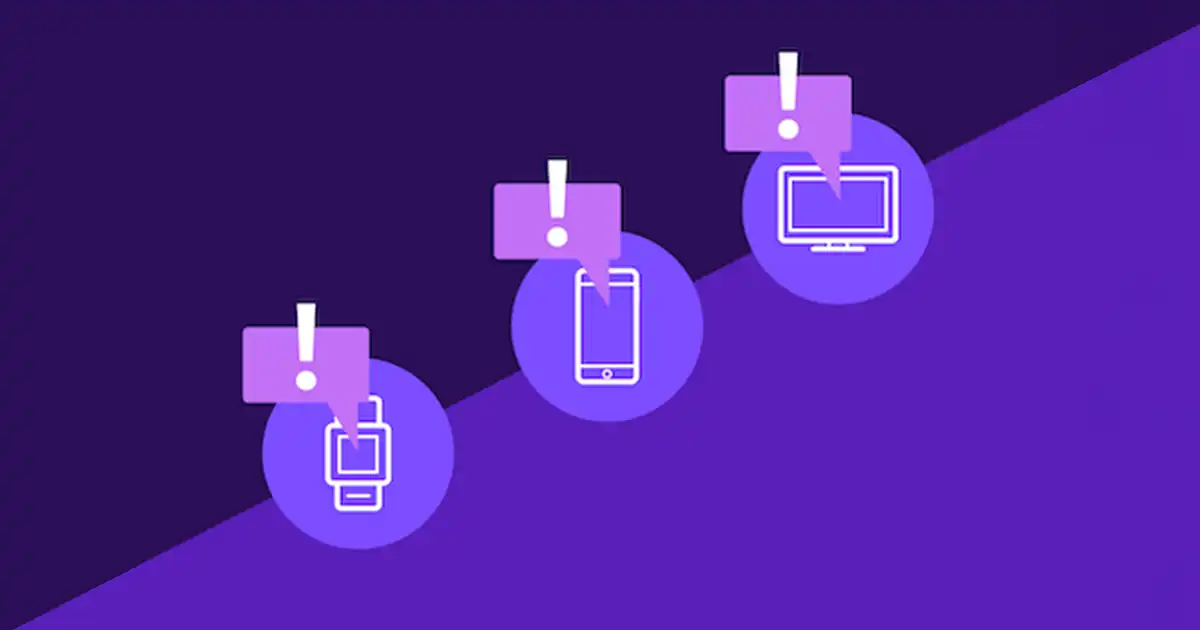
Have you ever been pleasantly surprised to open what seemed like a generic email to see it contained a personalized message? For example, receiving a discount code for that piece of furniture you’ve been researching — and recommendations for accessories you could order online and pick up at your local brick-and-mortar location?
That’s because you were on the receiving end of a thoughtful omnichannel experience. Unfortunately, this type of experience is all too rare. But with a little education and effort, it doesn’t have to be rare for your brand.
If you want your marketing program to leave a smile on consumers’ faces, it’s time to develop a strategy for delivering powerful omnichannel experiences.
In this guide, we’ll help you do just. We’ll answer questions about omnichannel experiences and show you:
What a real-life omnichannel marketing experience looks like to the consumer
The trends that make omnichannel experiences a must for modern businesses
Three strategies you can implement to boost your experiences from multichannel to omnichannel in a matter of weeks
Keep reading to learn how to take “omnichannel experience” from a buzzy phrase to a worthwhile strategy.
What is an omnichannel experience?
If you already use various channels to deliver marketing campaigns, you may think you’ve mastered the omnichannel experience. Close, but not quite.
A multichannel marketing experience involves a consumer interacting with your brand on multiple channels. So, while they may engage with marketing emails and content on your mobile app, they’re not enjoying a personalized or continuous experience as they move across channels.
The critical point is multichannel marketing can still leave consumers with fragmented information, a lackluster brand encounter, and no closer to becoming paying customers.
In contrast, an omnichannel experience isn’t only about various channels. It also means providing a cohesive flow for each consumer, so in the end, they’ll want to take action. This could be anything from purchasing your product to signing up for marketing emails.
An omnichannel experience puts the consumer at the center of the interaction by providing a captivating encounter that generic, fragmented marketing can’t touch.
How does it do this? By integrating each of your marketing channels, from in-store sales agents to social media platforms — in a way that enables you to provide each consumer with a seamless, personalized experience.
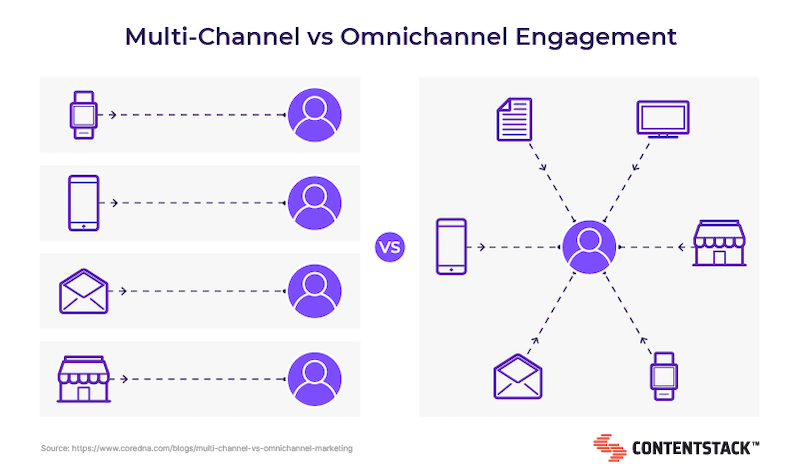
An example of an omnichannel experience?
Today’s buyer’s journey is neither predictable nor linear. This is a critical reason why omnichannel marketing is necessary. See how our example consumer, Chen, interacts with a brand that provides an optimal omnichannel experience.
Chen knows she wants to purchase a new laptop. So she pulls out her smartphone to research the options at a local store. While on the store’s mobile-optimized website, Chen interacts with an automated chatbot to schedule an appointment to check out a product she likes.
When Chen arrives for her appointment, an in-store agent has the laptop she’s interested in ready for her to try out. Chen likes the laptop but doesn’t buy it right then because she thinks she can find it for a better price. But while casually looking at Facebook on her tablet the next day, she receives a personalized ad from the store. The ad offers her a discount for the same computer she wants.
Chen clicks on the ad, which directs her to the laptop’s product page on the store’s tablet-optimized website. From there, she completes her purchase. After the discount and delightfully easy transaction, Chen is upbeat. She decides to sign up to receive marketing emails from the store.
Chen is pleased when she receives an email from the store (after the one notifying her that her computer has shipped). The new email recommends accessories based on her laptop purchase and her previous shopping behavior on the store’s website.
Chen offers a realistic example of modern consumers and how they want to interact with brands across different channels and devices.
Unfortunately, the computer store in our example offers an ideal version of the omnichannel experience that many brands aren’t prepared to deliver today. If Chen’s story isn’t enough to convince you it’s time to upgrade your marketing to provide omnichannel experiences, consider the following facts.
The trends that prove it’s paramount for your brand to offer omnichannel experiences
The biggest reason brands must provide omnichannel experiences is that modern consumers demand them. A 2020 survey found the average American has access to over 10 internet-connected devices in their household. What are they doing with all these smart devices? They increasingly engage with brands to get their needed products and services.
At the start of the 21st century, consumers interacted with an average of two touchpoints to complete a purchase. Today, consumers interact with three times that for an average of six touchpoints before purchasing.
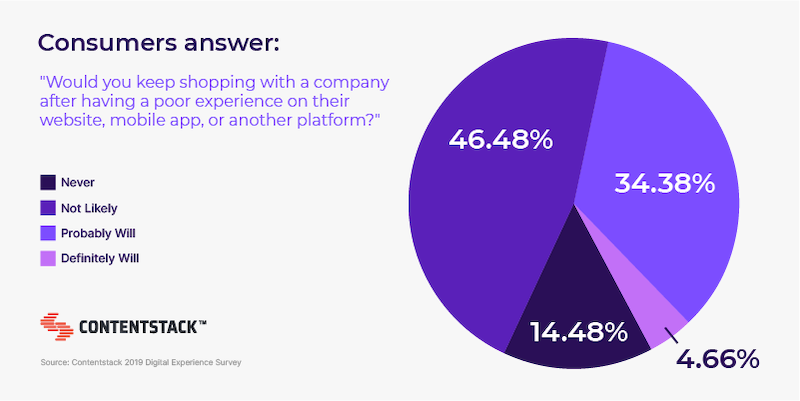
But it’s not only about shopper demands. There are plenty of compelling reasons why businesses deliver omnichannel experiences. For example, brands prioritizing omnichannel experiences can achieve an average customer retention rate of almost 89%. And they can achieve an average of 9.5% revenue growth year-over-year.
Compared to single-channel shoppers, omnichannel consumers spend an average of 4% more on every in-store shopping trip and 10% more online. They also have a 30% higher lifetime value. And they are more likely to recommend your brand to other shoppers.
The following section explores several ways to improve your marketing strategy to reap the rewards of providing a robust omnichannel experience.
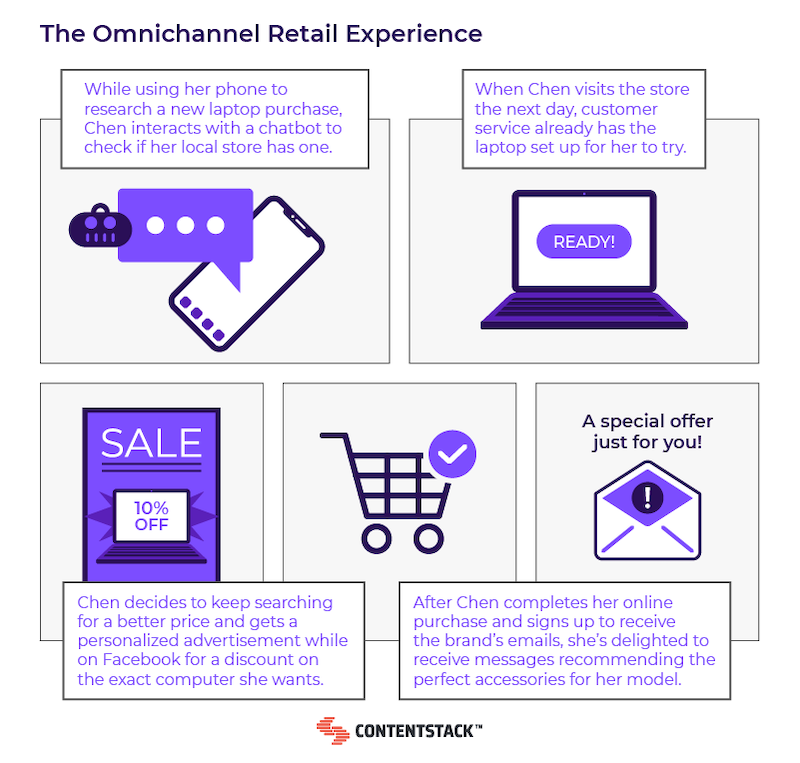
How to take brand marketing from multichannel to omnichannel experiences
Implementing an omnichannel marketing program can have its share of complexities. However, that doesn’t mean putting the processes in place to go omnichannel has to be complicated. Any marketing team ready to put in the effort can employ the following three strategies to go from multichannel to omnichannel in just a few weeks.
1. Gauge how consumers interact with your brand across channels
Aside from the technology for delivering omnichannel marketing, one of the essential elements of creating compelling omnichannel experiences is knowing how consumers interact with your marketing. Once you know that, you can identify areas for improvement.
This process starts with doing something called “mapping” the consumer journey.
Essentially, you list the touchpoints where consumers interact with your marketing. For example, a customer might click on a social media ad. They may land in your knowledge center after a random Google search. Or they could search for a specific product page after a friend told them about your brand.
Don’t be afraid to look outside the marketing department. Enlist everyone in your company who works with customers and may have insights. Think customer service, sales, and beyond. Another way to create this list of touchpoints is for your team members or hired usability testers to go through various consumer journeys to achieve different goals. Have them document marketing touchpoints along the way.
If making this list proves to be an overwhelming task for your limited resources or time frame, prioritize identifying the touchpoints for the most significant goals you have for people consuming your content. For example, you may want them to subscribe to marketing emails or make a purchase. By understanding how consumers interface with your brand and marketing messages, you now have a project to rally the team around.
2. Bring your team together to improve omnichannel experiences
Now that your team understands how consumers interact with your brand across channels and devices, it’s time to review each touchpoint and decide how to improve.
Here are some questions to ask about each touchpoint to rate its current performance:
Did the marketing message at the touchpoint help achieve your goal?
Did the touchpoint move the consumer to the next intended point in the customer journey?
Was there anything at this touchpoint that might have turned the consumer away?
What was the touchpoint missing?
Could advanced personalization have added to the experience?
Suppose you need help evaluating the touchpoints. You may repeat the same consumer journey mapping process as above. But this time, use a competitor’s digital channels. Knowing how the competition handles similar consumer interactions may help you see where your touchpoints are underperforming.
Your goal in this step is to identify how to improve consumer interactions with your marketing across channels. These interactions should include before, during, and after the buying journey.
For example, there’s little point in optimizing the ease of purchasing a product if your marketing campaigns are dropping people on landing pages where they can’t navigate to the products they want.
Next, you must implement a strategy to make the identified improvements. This will likely pull in people from all over your organization. For instance, you may need user experience designers to update website workflows, copywriters to help make sales messaging more effective, and so on.
Suppose you find that manually adjusting your omnichannel experience isn’t enough to meet consumer demands and reap the rewards you want. In that case, there is a power move you can make to boost your omnichannel marketing experiences – implement a headless CMS.
3. Power up your omnichannel experiences with a headless CMS
Most businesses with a dedicated marketing department use a content management system (CMS), which is a good thing. What’s not so good is that you miss out on delivering omnichannel marketing experiences at scale with a traditional CMS.
Traditional CMSes were built before personalized, around-the-clock omnichannel experiences were the norm. These old platforms were built to do one thing well — deliver static content to singular, static web pages. These monolithic systems can’t keep up with today’s omnichannel reality.
A more modern solution is a headless CMS built using MACH architecture. MACH is an acronym for an infrastructure built on microservices that deliver hyper-specific functions, connected with APIs that enable flexibility, live in the cloud to readily scale, and are headless for seamless content delivery across channels.
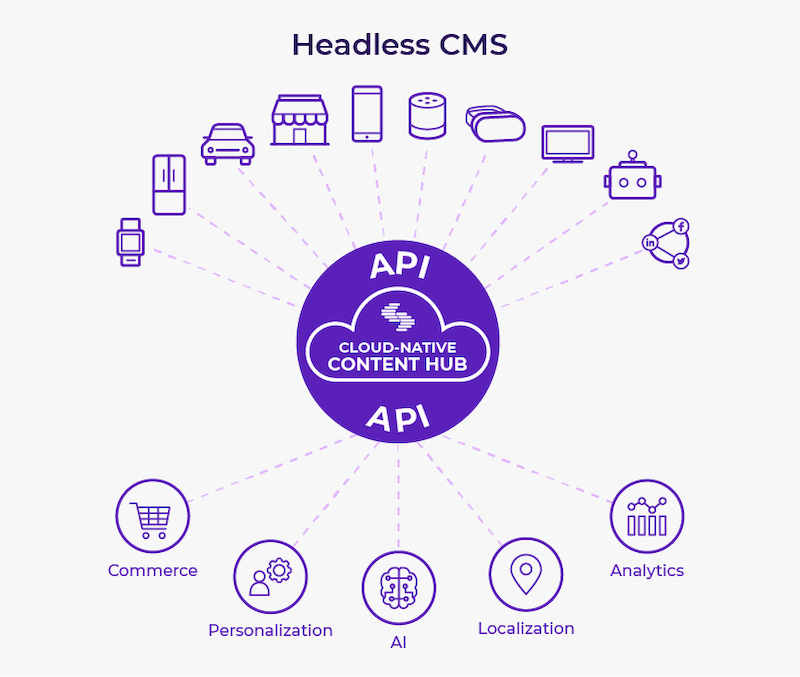
With a headless CMS, the presentation layer — including content creation, management, and publishing — is decoupled from the back end. This decoupling empowers marketing teams to publish content and IT teams to push tech updates without waiting on each other.
Additionally, this modularity means content can be created once, re-optimized using any personalization, localization, or other software you choose, and republished. The modular approach ensures content aligns with consumers’ needs, whether they’re interacting with a website, app, end-cap kiosk, chatbot, or any other cutting-edge marketing channel.
Critical components of an effective omnichannel strategy
In addition to headless CMS, four critical components of effective omnichannel strategies exist.
Data integration and analysis: utilizing customer data for personalized experiences
To improve customer relationships, data integration and analysis are crucial. Integrating customer data across multiple channels, such as in-store transactions, online purchases and live chat sessions, enables a comprehensive understanding of customer preferences and behaviors. This rich data can be used to craft personalized experiences, enhancing the shopping experience online and in physical stores.
Seamless user experience: ensuring smooth navigation and transactions across channels
Customers prefer consistency across various touchpoints, from browsing products online to visiting a physical store to receiving push notifications. To create a successful omnichannel experience, businesses must ensure smooth navigation and transactions across all channels. Seamless user experiences in the form of easy payment methods, synchronized shopping carts, and consistent branding improve the customer experience and build trust.
Customer relationship management: building and nurturing customer relationships
Effective omnichannel strategies strongly emphasize customer relationship management (CRM). This involves tracking customer interactions, ensuring prompt responses to inquiries and providing personalized assistance throughout the customer journey. An efficient CRM system helps boost customer satisfaction by meeting customers' expectations with proactive resolutions and tailored recommendations in every interaction.
Agile marketing: adapting marketing strategies based on customer behavior
As customer preferences evolve, so must your marketing strategies. Agile marketing enables businesses to adapt their campaigns in response to shifting customer behaviors. Combining data analysis with experimentation and iteration allows your omnichannel marketing strategy to drive engagement and sales with personalized, relevant, and timely content.
Mastering the four C's of omnichannel experiences
Creating successful omnichannel strategies requires a deep understanding of the four C's and how they can be applied in your business. By focusing on convenience, consistency, customization and communication, you can craft omnichannel experiences that meet and exceed customer expectations.
Convenience: Enhancing customer convenience across channels
Modern customers value convenience above all else. They prefer shopping platforms that cater to their needs and preferences, providing hassle-free experiences. By integrating online and offline platforms, businesses can offer customers the capability to browse products online while preserving the option to purchase them at a physical store. This integration between online platforms and brick-and-mortar stores significantly improves the customer experience and boosts customer satisfaction.
Consistency: Maintaining consistent messaging and branding
Consistency is the cornerstone of any successful omnichannel strategy. Maintaining uniform messaging and branding throughout all channels is crucial to improve customer trust and convey a clear, unified message. Here is where a headless CMS like Contentstack comes into play. Its robust features allow easy and efficient content management across different platforms without compromising the brand image. The result? A consistent experience that customers have come to expect.
Customization: Tailoring experiences to individual customer preferences
In the world of omnichannel retail, one size does not fit all. Knowing customer preferences and tailoring their shopping experiences fosters stronger customer relationships and enhanced satisfaction. Storing and analyzing customer data from various sources is paramount for effective customization. When you tailor the shopping experience based on customer preferences, you create a cohesive customer experience that resonates with your audience.
Communication: Seamless communication through various channels
Communication is the lifeblood of omnichannel marketing. Seamless communication between different channels is vital in delivering unified customer experiences. This includes integrating email, social media, live chat, and push notifications to create a comprehensive customer journey. Live chat and customer interactions are essential for businesses looking to boost satisfaction and improve overall customer service.
By integrating these principles into your omnichannel marketing strategy, you will be well-equipped to navigate the complex landscape of modern retail and create compelling customer experiences across all touchpoints.
Remember, in omnichannel, the customer is at the center of it all. By prioritizing their needs and expectations, you can create a shopping experience that truly resonates with them, ultimately driving customer loyalty and business growth.
Some common challenges when implementing omnichannel strategies
Here are some challenges you may encounter when implementing your new omnichannel strategy and how to solve these issues with the right technology.
Cohesive customer experience
In a successful omnichannel experience, customers should feel they’re shopping with a single vendor, regardless of channel. This requires processes for transferring customer data between different channels and keeping track of customer interactions. Mobile point-of-sale systems can record transactions and capture customer data if you manage a physical store. Then, this data can be leveraged to create targeted marketing campaigns or personalized offers.
Products online vs. physical stores
Having a wide range of products available online and in physical stores can be challenging. Businesses need efficient inventory management systems to synchronize product availability across different channels. Offering free in-store pickup for online orders can boost foot traffic, encourage in-store purchases and improve overall customer satisfaction.
Overcoming technological barriers in integration
Another significant challenge in implementing omnichannel strategies is integrating different platforms and tools. This is especially true when using legacy systems. Integrating various systems can be complex and time-consuming, but it's crucial for creating a unified customer experience. A headless CMS like Contentstack can be a game-changer in this regard.
Contentstack allows businesses to integrate with any platform or tool, enabling them to deliver consistent content across multiple channels quickly. Moreover, it allows businesses to manage content more easily with modular content blocks and advanced rich-text editing, boosting productivity and collaboration.
Enhancing Data Security and Privacy Across Channels
Securing customer data is especially important in an omnichannel environment. This is because customer data is collected and stored across multiple touchpoints, from online browsing behavior to in-store purchases and live chat interactions.
While personalizing the shopping experience based on this data can significantly improve customer satisfaction, it poses risks if handled incorrectly. Businesses must ensure they have robust security measures to protect customer data and comply with data privacy regulations.
In summary, while implementing omnichannel strategies poses some challenges, the benefits far outweigh any obstacles. With careful planning, the right technology, and a strong focus on data security, businesses can overcome these hurdles and succeed in today's omnichannel retail landscape.
Shifting to omnichannel experiences
Delightful omnichannel experiences in your marketing department don’t have to be few and far between. What’s more, modern brands are finding the shift to omnichannel experiences to be inevitable. This guide has given you everything you need to start making this transition. By implementing the strategies above, you can get a robust omnichannel marketing experience program off the ground in a few weeks.
To further deepen your knowledge about the world of omnichannel marketing, check out these other articles:
Learn more
Let us guide you in creating captivating, seamless, and personalized omnichannel experiences that meet and exceed your customers' expectations. We will help your organization understand the trends, implement effective strategies, and witness the transformation in customer interaction and satisfaction levels.
Discover the potential of omnichannel experiences and see how they can boost your customer retention rate and drive revenue growth.
Schedule a demo to elevate your brand's marketing from multichannel to omnichannel.
About Contentstack
The Contentstack team comprises highly skilled professionals specializing in product marketing, customer acquisition and retention, and digital marketing strategy. With extensive experience holding senior positions at renowned technology companies across Fortune 500, mid-size, and start-up sectors, our team offers impactful solutions based on diverse backgrounds and extensive industry knowledge.
Contentstack is on a mission to deliver the world’s best digital experiences through a fusion of cutting-edge content management, customer data, personalization, and AI technology. Iconic brands, such as AirFrance KLM, ASICS, Burberry, Mattel, Mitsubishi, and Walmart, depend on the platform to rise above the noise in today's crowded digital markets and gain their competitive edge.
In January 2025, Contentstack proudly secured its first-ever position as a Visionary in the 2025 Gartner® Magic Quadrant™ for Digital Experience Platforms (DXP). Further solidifying its prominent standing, Contentstack was recognized as a Leader in the Forrester Research, Inc. March 2025 report, “The Forrester Wave™: Content Management Systems (CMS), Q1 2025.” Contentstack was the only pure headless provider named as a Leader in the report, which evaluated 13 top CMS providers on 19 criteria for current offering and strategy.
Follow Contentstack on LinkedIn.




.svg?format=pjpg&auto=webp)
.svg?format=pjpg&auto=webp)
.png?format=pjpg&auto=webp)






.png?format=pjpg&auto=webp)

